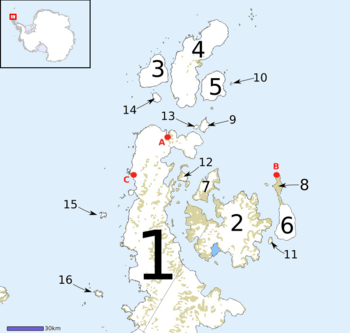James Ross Island group facts for kids

Map of Graham Land, showing James Ross Island (2), surrounded by the other members of the group
|
|
|
James Ross Island group (Antarctic Peninsula)
|
|
| Geography | |
|---|---|
| Location | Antarctica |
| Coordinates | 64°10′S 57°45′W / 64.167°S 57.750°W |
| Administration | |
| Administered under the Antarctic Treaty System | |
The James Ross Island group is a collection of islands found near the northeastern tip of the Antarctic Peninsula. This group includes some very important islands like James Ross Island, Snow Hill Island, Vega Island, and Seymour Island. These islands are located south of the Joinville Island group. The James Ross Island group is special because it hosts several scientific research stations and many important places where scientists find fossils.
Contents
Exploring the James Ross Island Group
The James Ross Island group is a fascinating part of Antarctica. It is known for its unique geography and its importance for scientific research. The islands are surrounded by cold waters and often covered in ice and snow.
Key Islands in the Group
The group is made up of several islands, each with its own interesting features.
- James Ross Island: This is the largest island in the group. It was named after Sir James Clark Ross, a famous British explorer.
- Snow Hill Island: This island is well-known for its large colony of Emperor penguins. It is a vital spot for studying these amazing birds.
- Vega Island: Scientists have found many plant fossils on Vega Island. These fossils tell us about what Antarctica was like millions of years ago.
- Seymour Island: This island is famous for its rich fossil discoveries, especially of ancient sea creatures and even dinosaurs.
Scientific Research and Discoveries
The James Ross Island group is a hotspot for scientists from all over the world. They come here to study the Earth's past, its climate, and its unique wildlife.
Palaeontology: Uncovering Ancient Life
One of the most exciting things about these islands is the discovery of fossils. Palaeontology is the study of ancient life through fossils. Scientists have found fossils of dinosaurs, ancient plants, and marine animals on these islands. These discoveries help us understand how life has changed on Earth over millions of years. For example, finding plant fossils shows that Antarctica was once much warmer and had forests!
Research Stations: A Home for Science
Several scientific bases are located in the James Ross Island group. One important base is Marambio Base, operated by Argentina. These bases provide a place for scientists to live and work while they conduct their research. They study everything from the weather and ice to the local animals and geology.
Wildlife of the Islands
Even though the islands are cold, they are home to many amazing animals.
- Penguins: You can find different types of penguins here, including Adélie penguins and Emperor penguins. They gather in large colonies, especially during breeding season.
- Seals: Various types of seals, like Weddell seals and Crabeater seals, can be seen resting on the ice or swimming in the waters around the islands.
- Birds: Many seabirds, such as skuas and petrels, also live and breed on the islands.
See also
 In Spanish: Grupo de la isla James Ross para niños
In Spanish: Grupo de la isla James Ross para niños


